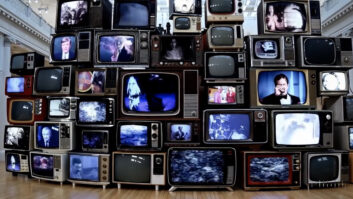By every important metric the sports video equipment market has had a great year in 2014. Major events like the World Cup and the Winter Olympics have been key drivers.
It was a year that saw massive building projects underway or coming to completion in every region of the world. Synchronously, sales of sports related video equipment in virtually all categories were up, more professional and educational stadia were getting built, more OB trucks outfitted and more TV sports studios created.
Even where new facilities were not being built, a lot of upgrading was underway, especially where the recession economics had previously held them back. An increasing number of new, more esoteric types of sports are finding their way onto small screens, ranging from TVs to mobile phones, as even the most exotic of sports is finding an audience.
Among newer sport coverages are: more women’s events, more children’s and school-sourced events and more esoteric interests such as fencing, chess boxing, synchronised swimming, dressage and bocce. To all intents and purposes the sports market is filled with overwhelmingly good news.
And the grumbles
Everything is great, so, why worry? Well, there is a growing concern in the sports market, specifically among respondents, that perhaps stadia are being overbuilt, that schools are devoting too much of their income and assets to sports. Sports spending in the US, for example, is averaging about 51% of total budgets at colleges, trumping every other category. This while students and their parents have been struggling under mountains of long term loan debt and dubious job prospects.
Public outcry in places like Brazil over rampant profits going out of the country to FIFA while the favelas continue to suffer drove tens of thousands into the streets have been in the news. US college athletes are beginning to organise unions to enable them to press for a share of bountiful college sports earnings, even at risk of their amateur status, a factor that can start impacting equipment spending.
Could these mean that there is trouble brewing in paradise? It could if such pressures caused a shrinking of sports budgets. That could lead to less money to spend on equipment.
The D.I.S. Consulting annual sports video report, published in June, called Sports Video World 2014 captures the dichotomy that is emerging in the marketplace. Overall, from the perspective of the purchasing of sports video products it’s still a generally pretty picture once more. I say once more because the sports market has been a consistent bright spot even though the worst days of the recession that started in 2008.
With the possible exception of the European market, which was hit particularly hard, sports spending and sports video equipment acquisition has continued to outperform virtually any other market application, as we reported in previous studies. And, even for Europe, it was often the strongest market area amid many weaker ones in the region.
Near demise of 3D
Talk about the light that failed. 3DTV channels fared miserably and fizzled. That represented a major setback in an otherwise seemingly boundless growth spurt among sports cable channels, globally. This caused major sports content players like ESPN and Sky to scale back 3D plans and curtail deployments or cancel services outright.
But, that false start has been amply made up for and is being replaced by Ultra High Definition and mainly by 4K technology. Sports venues and teams have enthusiastically embraced the move to higher definition and where 3D was intended and thwarted UHD is stepping in to take its place.
Not all sports related products are seeing growth at the same rates, and a few are even in a minor decline or running flat against recent years. Of the 12 sports related equipment categories tracked in the study, the healthiest growth is being seen in cameras, camcorders, D-SLRs, robotic camera systems, lenses, audio consoles and displays. The products covered in the study were: 1) cameras, 2) camcorders, 3) D-SLRs, 4) robotic camera systems, 5) lenses, 6) audio consoles, 7) displays, 8) tripods, 9) sports servers & still stores, 10) production switchers, 11) instant replay and 12) creative software.
Of the weaker reported categories were instant replay, where something of a saturation situation has been reached. Also key is that within categories like cameras, specific subsets like high-speed models represent pricey niche areas of spending.
Sports video budgets are generally looking up. In fact, of the total 1,669 survey respondents, worldwide, 1,176 stated they expected to see increases in the coming year, while only 296 said they expect declines and 197 said they expected that their budgets would remain the same.
In Europe, where there were 412 respondents this year, a healthy majority, 234, expect to see increased sports video budgets in the next year, only 49 expect to see declining sports video budgets and only 13 expect to see their sports video budgets remain the same. There were 116 who didn’t answer.
Year-on-year this indicates a strengthening in buying plans. That optimistic forecast speaks volumes about the prospects for improved spending on sports video kit in Europe in the coming year.
Despite the highly optimistic customer predictions, the results of the study also suggest the potential that a glut of facilities and overbuilding in OB vehicles could slow growth in the out years. That combined with ominously building pressures on budgets could also spell a tighter less ebullient sports video market in the next decade. That said, European countries have a bit of catching up to do when compared to other geographic regions in facilities terms, so there may be a bit more headroom here than elsewhere.






